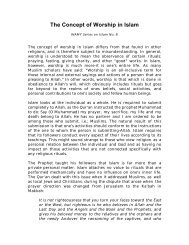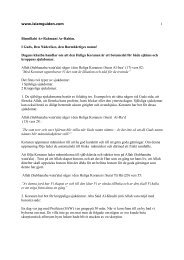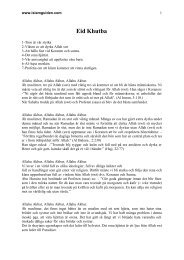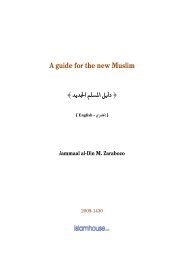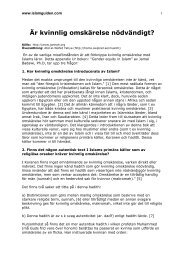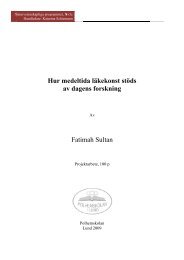Reach the Goal Via Tajweed Rules - Understand Quran
Reach the Goal Via Tajweed Rules - Understand Quran
Reach the Goal Via Tajweed Rules - Understand Quran
Create successful ePaper yourself
Turn your PDF publications into a flip-book with our unique Google optimized e-Paper software.
Teacher’s Class Notes<strong>Reach</strong> <strong>the</strong> <strong>Goal</strong> <strong>Via</strong><strong>Tajweed</strong> <strong>Rules</strong>Compiled by`t{t etá{xw
Table of ContentsIntroduction........................................................................................................................... 1<strong>Tajweed</strong>................................................................................................................................. 5Benefits of learning <strong>Tajweed</strong> .............................................................................................. 5<strong>Rules</strong> of Noon and Meem Mushaddad .................................................................................. 6Alqalqala ............................................................................................................................. 7The heavy and light letters.................................................................................................... 8Laam in <strong>the</strong> exalted name of Allah ..................................................................................... 10Ruling of RAA letter being heavy or light........................................................................... 12<strong>Rules</strong> of Noon Saakinah and Tanween .............................................................................. 13Izhaar Halqy ....................................................................................................................... 14Iqlaab ................................................................................................................................. 15Idghaam .............................................................................................................................. 16Ikhfaa Haqiqi .................................................................................................................... 18Chart for <strong>Rules</strong> of Noon saakin and Tanween.................................................................... 20How to pronounce each rules ............................................................................................. 21<strong>Rules</strong> of Meem Saakin ....................................................................................................... 24Ikhfaa Shafawi .................................................................................................................... 24Idghaam Mutama<strong>the</strong>layn Sagheer .................................................................................... 25Izhaar Shafawi .................................................................................................................... 25Chart for <strong>Rules</strong> of Meem Saakin......................................................................................... 26Al-Madd .............................................................................................................................. 27
Maddd Tabee'...................................................................................................................... 28Madd Badal ....................................................................................................................... 29Madd Ewad ......................................................................................................................... 29Maddd Aridh Lissukoon...................................................................................................... 30Maddd Leen ........................................................................................................................ 30Madd Wajib Mutassil ........................................................................................................ 31Madd Jae'z Munfasil........................................................................................................... 31Madd Laazim .................................................................................................................... 32Madd Laazim Kalemee Muthaqqal..................................................................................... 32Madd Laazim Kalemee Mukhaffaf..................................................................................... 33Madd Laazim Harfee Muthaqqal........................................................................................ 33Madd Laazim Harfee Mukhaffaf......................................................................................... 34Chart for Madd ................................................................................................................... 35Stopping at <strong>the</strong> end of words ............................................................................................. 36The Qualities of <strong>the</strong> letters.................................................................................................. 37Permenant Qulities with opposites ..................................................................................... 38Al-Jahr and Al-Hams ....................................................................................................... 38Asheddah, Attawasut and Arrakhawa ................................................................................ 39Istifaal and Iste'elaa........................................................................................................... 40Al-infetaah and Al-Itbaaq ................................................................................................... 40Al-Izlaaq and Al-Ismaat...................................................................................................... 40Permenant Qulities without opposites ................................................................................ 41Alqaqala ............................................................................................................................ 41
As-Safeer............................................................................................................................. 42Al-Leen ............................................................................................................................... 42Al-Inhiraf............................................................................................................................. 42At-Takreer .......................................................................................................................... 43At-Tafasshy ......................................................................................................................... 43Istitaalah ............................................................................................................................ 43Referances........................................................................................................................... 44
<strong>Reach</strong> <strong>the</strong> goal via <strong>Tajweed</strong> rule1 st editionIntroductionWhat is <strong>Tajweed</strong>?The word <strong>Tajweed</strong> linguistically means ‘proficiency’ or ‘doing something well’.When applied to <strong>the</strong> Qur’an, it means giving every letter of <strong>the</strong> Qur’an its rights and dues ofcharacteristics when we recite <strong>the</strong> Qur’an and observing <strong>the</strong> rules that apply to those letters indifferent situations. We give <strong>the</strong> letters <strong>the</strong>ir rights by observing <strong>the</strong> essential characteristicsof each letter that never leave it. And we give <strong>the</strong>m <strong>the</strong>ir dues by observing <strong>the</strong>characteristics of each letter that are present in <strong>the</strong>m some of <strong>the</strong> time and not present at o<strong>the</strong>rtimes.The Qur’an was revealed with <strong>Tajweed</strong> rules applied to it. In o<strong>the</strong>r words, when <strong>the</strong>angel Jibreel ((AS)) recited <strong>the</strong> words of Allah to <strong>the</strong> Prophet Muhammad (SAW) he recited<strong>the</strong>m in a certain way and he showed <strong>the</strong> Prophet (SAW) <strong>the</strong> ways in which it waspermissible to recite <strong>the</strong> Qur’an. So it is upon us to observe those rules so that we recite it in<strong>the</strong> way it was revealed.History of <strong>Tajweed</strong>At <strong>the</strong> time of <strong>the</strong> Prophet (SAW) <strong>the</strong>re was no need for people to study <strong>Tajweed</strong>because <strong>the</strong>y talked with what is now known as <strong>Tajweed</strong> so it was natural for <strong>the</strong>m. When <strong>the</strong>Arabs started mixing with <strong>the</strong> non-Arabs as Islam spread, mistakes in Qur’an recitationstarted appearing, so <strong>the</strong> scholars had to record <strong>the</strong> rules. Now, because <strong>the</strong> everyday Arabicthat Arabs speak has changed so much from <strong>the</strong> Classical Arabic with which <strong>the</strong> Qur’an wasrevealed, even Arabs have to study <strong>Tajweed</strong>.The purpose of <strong>Tajweed</strong>The Qur’an is <strong>the</strong> word of Allah, and its every syllable is from Allah. Its recitationmust be taken very seriously. The purpose of <strong>the</strong> Science of <strong>Tajweed</strong> in essence is to make<strong>the</strong> reciter proficient in reciting <strong>the</strong> Qur’an, observing <strong>the</strong> correct pronunciation of everyletter with <strong>the</strong> rulings and characteristics which apply to each letter, without any exaggerationor deficiency. And so through this <strong>the</strong> reciter can recite <strong>the</strong> Qur’an upon <strong>the</strong> way of <strong>the</strong>Prophet pbuh. as he received it from Jibreel who received it from Allah (SWT) in <strong>the</strong>Classical Arabic dialect that it came down in.Arabic letters each have a Makhraj – an exit or articulation point - in <strong>the</strong> mouth orthroat from which <strong>the</strong>y originate and <strong>the</strong>y also each have Sifaat – attributes, or characteristics- particular to <strong>the</strong>m. Knowing <strong>the</strong> Makhraj and Sifaat of each letter is an important part of<strong>Tajweed</strong>. Sometimes two letters have very similar exits which makes mixing <strong>the</strong>m up easy.So if a person does not know <strong>the</strong> attributes of each letter <strong>the</strong>re is a danger that he will change<strong>the</strong> meaning of <strong>the</strong> words in Qur’an recitation. Observing <strong>the</strong> rules of <strong>Tajweed</strong> in recitingprotects <strong>the</strong> reciter from making mistakes in reciting <strong>the</strong> Qur’an.The ruling of reading with <strong>Tajweed</strong>Muhammad bin Al-Jazaree <strong>the</strong> great Qur’an and Hadeeth scholar of <strong>the</strong> 9th Century(Hijri) says in his famous poem, detailing <strong>the</strong> rules of <strong>Tajweed</strong>: “And applying <strong>Tajweed</strong> is an1
<strong>Reach</strong> <strong>the</strong> goal via <strong>Tajweed</strong> rule1 st editionissue of absolute necessity, whoever doesn’t apply <strong>Tajweed</strong> to <strong>the</strong> Qur’an, <strong>the</strong>n a sinner ishe.”So he regarded it as an obligation and he regarded leaving it as a sin. And <strong>the</strong>majority of scholars agree that applying <strong>the</strong> <strong>Tajweed</strong> rules of Qur’an are an individualobligation ( ) upon every Muslim who has memorized or read part of or all of <strong>the</strong>Qur’an. That is because <strong>the</strong> Qur’an was revealed with <strong>the</strong> <strong>Tajweed</strong> rules applied to it and <strong>the</strong>Prophet (SAW) recited it back to Jibreel in that way and <strong>the</strong> Companions of <strong>the</strong> Prophet(SAW) read it in that way, so it is an established Sunnah.The obligation of <strong>Tajweed</strong>The proofs that <strong>the</strong> scholars bring to show <strong>the</strong> obligation of <strong>Tajweed</strong> is that Allahsays in <strong>the</strong> Qur’an,∩⊆∪ ¸ξ‹Ï?ös? tβ#uöà)ø9$# È≅Ïo?u‘uρ ϵø‹n=tã ÷ŠÎ— ÷ρr&The meaning of which is: ‘And recite <strong>the</strong> Qur’an (aloud) in a (slow and melodious) style(tarteela)’ (Surah Muzzammil, Ayah 4)Ali ibn Abi Talib (RA) said in <strong>the</strong> explanation of this aayah: “at-Tarteel is <strong>Tajweed</strong> of<strong>the</strong> letters and knowing where to stop (correctly)”.[An-Nashr of Ibn Al-Jazaree 209:1]And of <strong>the</strong> rights of reciting correctly is reciting it <strong>the</strong> way it was revealed. There arevarious Ahadeeth also showing us <strong>the</strong> importance of <strong>Tajweed</strong>. Umm Salamah was askedabout <strong>the</strong> recitation of <strong>the</strong> Prophet (SAW) and she described it as a recitation ‘clearlydistinguishedletter by letter’.[Tirmidhi]Sa’eed bin Mansoor relates in his Sunan that a man was reciting <strong>the</strong> Qur’an toAbdullah bin Mas’ood and he recited “Innamas sadaqaatu lil fuqara-i wal masaakeen”, so Ibnmas’ood said: “This was not how <strong>the</strong> Messenger of Allah (SAW) recited it to me!” So <strong>the</strong>man asked, “How did he read it to you oh Aba Abdir-Rahman?” So he said “Lil Fuqaraaaa-iwal masaakeen”, he elongated <strong>the</strong> word Fuqaraa and <strong>the</strong> knowledge of <strong>the</strong> different lengthsof elongation (mudood) is also from <strong>the</strong> rules of <strong>Tajweed</strong>.Ibn al-Jazari (may Allaah have mercy on him) said: Whoever is able to read <strong>the</strong>words of Allah with correct Arabic pronunciation but he deliberately pronounces itincorrectly like a non-Arab, out of arrogance, stubbornness and complacency, or because heis too proud to go to a scholar who could help him to correct his pronunciation, isundoubtedly falling short and sinning and being dishonest. The Messenger of Allaah (pbuh)said: “Religion is sincerity: to Allah, to His Book, to His Messenger, and to <strong>the</strong> leaders of <strong>the</strong>Muslims and <strong>the</strong>ir common folk.”It is not permissible for anyone to deliberately change any letter of it when he is ableto pronounce it correctly. This is a kind of mistake which is a sin. If a person finds it difficult2
<strong>Reach</strong> <strong>the</strong> goal via <strong>Tajweed</strong> rule1 st editionto pronounce <strong>the</strong> letters correctly – such as people in whose language some of <strong>the</strong> Arabicletters, such as ظ , ذ and خ do not exist – <strong>the</strong>y have to try to learn <strong>the</strong> correct pronunciation,but if <strong>the</strong>y are unable to master it <strong>the</strong>n <strong>the</strong>y are excused, but <strong>the</strong>ir example should not befollowed, and <strong>the</strong>y should be called upon to strive <strong>the</strong>ir hardest to learn and correct <strong>the</strong>irpronunciation. And none of <strong>the</strong>m should lead <strong>the</strong> prayer, unless he is leading o<strong>the</strong>rs like himwho cannot pronounce well ei<strong>the</strong>r. (1)Mistakes in <strong>Tajweed</strong>:-The scholars have divided <strong>the</strong> types of mistakes one might fall into when reciting <strong>the</strong> Qur’aninto two types:1.Clear mistakes and2.Unobvious (hidden) mistakes.The Clear mistakes must be avoided by all and to avoid <strong>the</strong>m one must know <strong>the</strong> rulesof <strong>Tajweed</strong>. If a person falls into <strong>the</strong> Clear Mistakes, this is considered a sin and IbnTaymiyyah even regarded it undesirable for a Student of Knowledge (i.e. someone whoknows <strong>Tajweed</strong>) to pray behind a person who makes Clear Mistakes in <strong>the</strong>ir Salaah. As for<strong>the</strong> Unobvious mistakes, <strong>the</strong>n <strong>the</strong> ruling on <strong>the</strong>m is lighter and <strong>the</strong> recitation of a personfalling into this type of mistake is regarded as lacking in completeness and prayer behindsuch a person is sound.Reciting <strong>the</strong> Qur’an melodiouslyThe Prophet (SAW) used to recite <strong>the</strong> Qur’an in slow, measured, rhythmic tones asAllah had instructed him, not hurriedly, but ra<strong>the</strong>r “he would recite a surah in such slowrhythmic tones that it would be longer than it would seem possible.”[Muslim, Muwatta] Hewould stop at <strong>the</strong> end of each aayah [Abu Dawud]. He commanded people to recite in abeautiful voice in a pleasant melodious tone. He said “Beautify <strong>the</strong> Qur’an with your voices[for a fine voice increases <strong>the</strong> Qur’an in beauty]”[Bukhari] and he said “He who does notrecite <strong>the</strong> Qur’an in a pleasant tone is not of us.”[Abu Dawud]Unfortunately all too often we find people reciting <strong>the</strong> Qur’an quickly and withoutchanging <strong>the</strong>ir tone and without any feeling. We should put all our efforts into reciting <strong>the</strong>Qur’an with as much feeling as we can! Have you ever prayed behind an Imam who readwith feeling? Well <strong>the</strong> Prophet (SAW) said “Truly <strong>the</strong> one who has one of <strong>the</strong> finest voicesamong <strong>the</strong> people for reciting <strong>the</strong> Qur’an is <strong>the</strong> one whom you think fears Allah when youhear him recite.”[Daarimi, Tabaraani]And once when <strong>the</strong> Prophet (SAW) complimented Abu Moosaa al-Ash’ari on <strong>the</strong>beauty of his recitation, Abu Moosaa said “Had I known you were <strong>the</strong>re, I would have mademy voice more pleasant and emotional for you.”[Bukhari, Muslim]Let us remember, that <strong>the</strong> Qur’an is <strong>the</strong> word of Allah. In it we find exhortations,warnings, glad-tidings, parables, stories of <strong>the</strong> past, commands and prohibitions. Aayaat tomake us think, reflect, cry, fear, hope, love, fall down in prostration! How can we recite all of1 67586 www.islam-qa.com3
<strong>Reach</strong> <strong>the</strong> goal via <strong>Tajweed</strong> rule1 st editionthis without feeling!? When we recite an aayah of Qur’an we should imagine that we aretrying to feel and convey <strong>the</strong> full message behind that aayah. Perhaps some of us don’t feelconfident.I believe that this lack of confidence comes partly from not knowing <strong>the</strong> rules of<strong>Tajweed</strong> correctly and so fearing that we will make mistakes and partly from notunderstanding <strong>the</strong> meaning of what we are reciting. So let us work hard to remove <strong>the</strong>se twoobstacles by learning <strong>Tajweed</strong> and working towards learning Arabic.Helpful Tips towards learning <strong>Tajweed</strong>* You must find a Qur’an teacher who has studied <strong>Tajweed</strong> to listen to your recitation andcorrect you. <strong>Tajweed</strong> cannot merely be learnt from books, because <strong>the</strong> movements of yourmouth as well as <strong>the</strong> sounds are important and only a teacher can correct you and make sureyou are applying <strong>the</strong> rules correctly. Qur’an recitation is a science which was passed downgeneration by generation through teachers not just books, with a direct line to <strong>the</strong> Prophetpbuh.* Follow this book containing <strong>the</strong> rules of <strong>Tajweed</strong> and learn each rule little by little,applying it as you go along with <strong>the</strong> help of your teacher. Following <strong>the</strong> charts will make iteven better to understand and remember <strong>the</strong> rules InshaaAllah.* Listen to Qur’an tapes of reciters who recite very clearly (you can find that also atwww.reciter.org), at a medium or slow speed and notice <strong>the</strong>m applying <strong>the</strong> different rules of<strong>Tajweed</strong>. Repeat after <strong>the</strong>m while trying to apply <strong>the</strong> rules you’ve learnt. Try to copy <strong>the</strong>irtone and melody as well and see how it changes as <strong>the</strong> meaning of what <strong>the</strong>y’re recitingchanges.* Apply <strong>the</strong> rules you learn to <strong>the</strong> Surahs you have already memorized and don’t save anyeffort about reciting correctly. You might have to revise <strong>the</strong> surahs by looking back at <strong>the</strong>m.* Practice and repetition will make perfect InshaaAllah: As Ibn al-Jazaree says in his poemabout acquiring <strong>Tajweed</strong>: ‘And <strong>the</strong>re is no obstacle between it (learning <strong>Tajweed</strong>) andleaving it, Except that a person must exercise his mouth with it!’May Allah help us all to give His Book its right when we recite it and make reciting it morebeloved to our tongues than anything else. Aameen.`t{t `A etá{xw4
<strong>Reach</strong> <strong>the</strong> goal via <strong>Tajweed</strong> rule1 st edition<strong>Tajweed</strong>The linguistic meaning of <strong>Tajweed</strong> is (to beautifysomething).The technical meaning of <strong>Tajweed</strong> is (to give every letter its right with its description and its origination)Benefits of learning <strong>Tajweed</strong>The benefits of learning <strong>Tajweed</strong> are many as reflected in some of <strong>the</strong>following Ahadeeth:• The reciters of <strong>the</strong> Qur’an will be in <strong>the</strong> company of <strong>the</strong> noble andobedient angels‘Aa’ishah, may Allah be pleased with her, relates that <strong>the</strong> Prophet(SAW) said: “Verily <strong>the</strong> one who recites <strong>the</strong> Qur’an beautifully,smoothly, and precisely, he will be in <strong>the</strong> company of <strong>the</strong> noble andobedient angels. And as for <strong>the</strong> one who recites with difficulty,stammering or stumbling through its verses, <strong>the</strong>n he will have TWICEthat reward.” [Al-Bukhari and Muslim]• You will be from <strong>the</strong> best of people‘Uthmaan, may Allah be pleased with him, said that <strong>the</strong> Prophet(SAW) said: “The best of you are <strong>the</strong> ones who learn <strong>the</strong> Qur’an andteach it to o<strong>the</strong>rs” [Al-Bukhari]• There are ten rewards for each letter you recite from <strong>the</strong> <strong>Quran</strong>“Whoever reads a letter from <strong>the</strong> Book of Allah, he will have areward. And that reward will be multiplied by ten. I am not sayingthat “Alif, Laam, Meem” is a letter, ra<strong>the</strong>r I am saying that “Alif” is aletter, “laam” is a letter and “meem” is a letter.” [Tirmidhi states thisis saheeh]• The Qur’an will lead you to Paradise!The Qur’an is an intercessor, something given permission tointercede, and it is rightfully believed in. Whoever puts it in front ofhim, it will lead him to Paradise; whoever puts it behind him, it willsteer him to <strong>the</strong> Hellfire.” [An au<strong>the</strong>ntic hadith found in At-Tabaraanee, on <strong>the</strong> authority of ‘Abdullaah ibn Mas’ood]5
<strong>Reach</strong> <strong>the</strong> goal via <strong>Tajweed</strong> rule1 st edition<strong>Rules</strong> of Noon and Meem Mushaddad • The way of pronouncing:If a Meem or Noon is Mushaddad (that is, it has a shaddah sign on it), <strong>the</strong>reader must do Ghunnah (or Nasal sound) of 2 (beats) on it.Note: if <strong>the</strong> reader stops on a word ending with Noon or MeemMushaddad, <strong>the</strong> Gunnah for <strong>the</strong> Meem or Noon Mushadad still have tobe applied.• Examples:-zΟ¨Ψyγpg¿2ÏπuŠÏ¹$¨Ζ9$Î/Ĩ$¨Ψ9$#χãρutIs9¨βr&!$¯ΡÎ)…絕Βé'sù$¨Βr'sù!$¨Βr&uρ§Νtã6
<strong>Reach</strong> <strong>the</strong> goal via <strong>Tajweed</strong> rule1 st edition• The meaning of Qalqalah:Al –QalqalahMeans vibration, it is <strong>the</strong> vibration of sound at <strong>the</strong> end of <strong>the</strong>pronunciation of a letter.It can be stated as a state between a Saakin (letter with Sukoon sign on it)and Mutaharrik (letter with Movement)Note: Qalqalah is only pronounced when <strong>the</strong> letter is Saakin (ei<strong>the</strong>r <strong>the</strong>letter has <strong>the</strong> Sukoon sign or is assigned a sukoon because of stopping).• Letters of Qalqalah:• Examples:They are collected in <strong>the</strong> words [ ] OR [ ]Ædkysø9$#uρî‰ymr&x8u‘ô‰|¹‘,ptø:$#߉yϑ¢Á9$#ΟßγyϑyèôÛr&¡=s?uρy‰|¡ymçtIö/F{$#StrongestStrongWeak7
<strong>Reach</strong> <strong>the</strong> goal with <strong>Tajweed</strong> rule 1 st editionThe Heavy and light Lettersحروف التفخيم والترقيقTypes of Arabic lettersconsidering <strong>the</strong>ir heavinessand lightnessHeavy lettersTemporary heavyand lightLight lettersThe followinglettersخص ضغط قظLetter ()() Madd حرف الراSee chart page (12) If <strong>the</strong>precedingletter is heavyAlif Madd shouldbe pronouncedheavyThe AlifIf <strong>the</strong>precedingletter is lightAlif Madd shouldbe pronouncedlightIf <strong>the</strong>followingletter is heavyGhunnahshould beheavyThe Ghunnahfor IkhfaaHaqiqi If <strong>the</strong>followingletter is lightGhunnahshould belightLaam () in<strong>the</strong> Exaltedname of Allah – See chart page(10)The Restof <strong>the</strong>letters8
<strong>Reach</strong> <strong>the</strong> goal via <strong>Tajweed</strong> rule1 st edition-:الحروف المفخمة 1. Heavy lettersThey are collected in <strong>the</strong> phrase[ظ ق ط غ ض ص خ] OR [خص ضغط قظ]• The way of pronouncing a Heavy Letter:-The heavy letters have <strong>the</strong> quality of Isti’laa 2 “rising high”.Because while pronouncing <strong>the</strong>m, a part of <strong>the</strong> tongue (mostly <strong>the</strong> backpart) rises up to <strong>the</strong> roof makes <strong>the</strong> letter sound heavy.:- الحروف المرققة 2. Light lettersAll <strong>the</strong> letters o<strong>the</strong>r than <strong>the</strong> heavy letters and <strong>the</strong> temporary heavyand light letters.• The way of pronouncing Light Letters:The Light Letters have <strong>the</strong> quality of Istifaal 3 “falling down”, bylowering <strong>the</strong> tongue when pronouncing <strong>the</strong> light letter.ألف المد 3. Alif MaddThe quality of Alif Madd being heavy or light depends on <strong>the</strong> letterpreceding Alif Madd. If <strong>the</strong> letter before Alif Madd was light, so Alif Maddshould accordingly take a light sound. And if <strong>the</strong> letter before Alif Maddwas heavy, so Alif Madd should accordingly take a heavy sound.4. The Ghunnah for Ikhfaa HaqiqiSee page 23 from <strong>Rules</strong> of Noon Saakinah and Tanween.2 See page 40 for more details about Isti’laa3 See page 40 for more details about Istifaal9
<strong>Reach</strong> <strong>the</strong> goal via <strong>Tajweed</strong> rule1 st editionاللام فى لفظ 5. <strong>Rules</strong> for The Laam of The Exalted Name of AllahالجلالةThis is one of <strong>the</strong> temporary Qualitiesa) If <strong>the</strong>re is a Fatha or a Dhamma before <strong>the</strong> word of Allah orAllahum, <strong>the</strong>n laam in Allah will be heavy.Example:¢Οßγ¯=9$#(#θä9$s%§Νßγ¯=9$#šoΨ≈ysö6ߪ!$#u!$t±o„ª!$#uρb) If <strong>the</strong>re is a kasrah before <strong>the</strong> word Allah, <strong>the</strong>n <strong>the</strong> Laam inAllah or Allahum will be lightExample:¢Οßγ¯=9$#È≅è%«!$#Ç⎯ƒÏŠ¬!«!$Î/c) If <strong>the</strong> reader starts reading with <strong>the</strong> name of Allah, <strong>the</strong>n Laamin Allah or Allahom will be heavy.============================================10
<strong>Reach</strong> <strong>the</strong> goal via <strong>Tajweed</strong> rule1 st editionLaam () in <strong>the</strong>Exalted name of Allah - If <strong>the</strong> letterbefore <strong>the</strong> nameof Allah has fathahorDhammahIf reader startsreading with <strong>the</strong>name of AllahIf <strong>the</strong> letterbefore <strong>the</strong> nameof Allah hasKasrahLamm in Allahshould beheavyLamm inAllahshould belight11
<strong>Reach</strong> <strong>the</strong> goal via <strong>Tajweed</strong> rule1 st edition(مرققة)LIGHT or (مفخمة)HEAVY being (ر)’Raa 4. Ruling ofDepends on <strong>the</strong>(ر) Raa’ Harakah onَ ُHeavyôLook at <strong>the</strong>previous letterَLightَ ُو or ا OrHeavyَ LightExcept forôHamzatulWasslHeavy(#þθç/$s?ö‘$# ÇΠr&letter Yaa’(ى)Lightîöyz#YŠ$|¹óÉ∆ÏŠ$|¹öÏϑø9$Î7s9#YŠ$|¹ö‘Î)uρ
<strong>Reach</strong> <strong>the</strong> goal via <strong>Tajweed</strong> rule1 st editionThe <strong>Rules</strong> of Noon Sakin and Tanween • Noon Saakinah: is a Noon with no Harakah or with a Sukoon sign onit.Noon Saakinahôنن ن.• Tanween:- Is actually a noon Saakinah which comes at <strong>the</strong> end of <strong>the</strong>nouns. It is pronounced but not written as Noon Saakinah.Tanween7¥R×7Yí>·Note: - Tanween only occurs at <strong>the</strong> end of nouns (except for two verbs)whereas Noon Saakinah may occur anywhere in a word (in <strong>the</strong> middle or at<strong>the</strong> End).<strong>Rules</strong> of Noon Saakinah and Tanween 4• Izhar Halqi • Idgham • Iqlaab • Ikhfaa’ Haqiqi 4 Please refer to <strong>the</strong> chart page 20 to be able to find <strong>the</strong> rule and apply it while reciting <strong>Quran</strong>13
<strong>Reach</strong> <strong>the</strong> goal via <strong>Tajweed</strong> rule1 st editionFirst: Izhaar Halqi • Izhaar means “clear”• Izhaar Letters: <strong>the</strong> throat letters • The way of pronunciation :-If a Noon Saakin or a Tanween is followed by any of <strong>the</strong> six throatletters, The Noon Saakin or <strong>the</strong> Tanween is pronounced clearly from itsrespective origination without Ghunnah.• Examples on Noon Saakin ôنz©Å´yz ô⎯yϑÏ9öΝåκ÷]tãÈ≅÷δr&ô⎯ÏΒÄd“r&ô⎯ÏΒ|Môϑyè÷Ρr&4‘sS÷Ζtƒ• Examples on Tanweení>·}‘Ïδ íΟ≈n=y#sŒÎ)#´‰ö7tã$pκön=tæ >‹Í×tΒöθtƒ7πy∞ÏÛ%s{ >πt/É‹≈x.ωÎ)îΠ$yèsÛîπyèϱ≈yz >‹Í×tΒöθtƒNote:- If <strong>the</strong> Tanween is followed by Hamzatul wassl ( ), <strong>the</strong> reader issupposed to pronounce <strong>the</strong> noon in <strong>the</strong> Tanween like Noon with Kasrah.Example:”s)tGó¡çRùQ$# >‹×tΒöθtƒ14
<strong>Reach</strong> <strong>the</strong> goal via <strong>Tajweed</strong> rule1 st editionSecond: Iqlaab • Iqlaab means: - “to turn over”• Iqlaab letters:- “”• The way of pronunciation:-If a Noon Saakin or Tanween is followed by ,”ب“ it is converted into ahidden Meen with separating between lips. And <strong>the</strong> reader should makeGhunnah for 2 beats• Examples on Noon Saakin$uΖ÷Kt7/Ρr'sùω÷èt/.⎯ÏΒ• Examples on TanweenzΟ¨Ψyγpg¿2 ¥‹Í×tΒöθtƒÏπuŠÏ¹$¨Ζ9$Î/$Jèxó¡oΨs915
<strong>Reach</strong> <strong>the</strong> goal via <strong>Tajweed</strong> rule1 st editionThird: Idghaam • Idghaam means: -“To mix” or to “put one thing into ano<strong>the</strong>r”. It is <strong>the</strong> mixing or enteringof a Saakin letter into a Mutaharrik letter following it, so that <strong>the</strong>y became asingle Mushaddad letter.• Idghaam Letters:-”يرملون“ There are six letters of Idghaam which are collected in <strong>the</strong> wordNote: <strong>the</strong> Noon Saakin or <strong>the</strong> Tanween and <strong>the</strong> Idgham letter have to be intwo different words, o<strong>the</strong>rwise <strong>the</strong> reader is not Supposed to do Idghaam. Inthis case it will be Izhaar Motlaq مطلق) (إظهار and this case can be found onlyin 4 words in <strong>Quran</strong>$u‹÷Ρ‘‰9$# Ö⎯≈uŠ÷Ψç/ ×β#uθ÷ΖÏ% ×β#uθ÷ΖϹ• Types of Idghaam1- Idghaam with Ghunnah- The Letters for <strong>the</strong> Idghaam with Ghunnah: - " " " " "“ ""OR " "If <strong>the</strong> Noon Saakin or <strong>the</strong> Tanween is followed by any of <strong>the</strong>se fourletters, <strong>the</strong> reader should make Idghaam with Ghunnah for 2 beats.- The way of pronunciation:-Skip <strong>the</strong> Noon or Tanween and Pronounce Ghunna with <strong>the</strong> followingletter for 2 beats- Examples on Noon SaakinينموΝÍκÉ″!#u‘uρ⎯ÏΒ¤‰|¡¨Β⎯ÏiΒö≅yϑ÷ètƒ⎯yϑsùöΝä.y‰ƒÌ“¯Ρ⎯n=sù16
<strong>Reach</strong> <strong>the</strong> goal via <strong>Tajweed</strong> rule1 st edition- Examples on Tanween×πuΗ¿å$¯Ρ7‹Í×tΒöθtƒ7‹Í×tΒöθtƒÒ>θè=è%⎯ÏiΒ[!#t“y_Ÿωuρ#YŠöt/2- Idghaam without Ghunnah- The Letters for <strong>the</strong> Idghaam without Ghunnah: - " " " "If <strong>the</strong> Noon Saakin or <strong>the</strong> Tanween is followed by any of <strong>the</strong>se twoletters, <strong>the</strong>re is no Ghunnah while making <strong>the</strong> Idghaam.- The way of pronunciation:-Skip <strong>the</strong> Noon or Tanween and Pronounce ل or ر without Ghunna- Examples on Noon SaakinóΟ©9⎦Í.s!öΝÍκÍh5§‘⎯tã- Examples on TanweenÒΟŠÏm§‘ Ô∃ρâts9t⎦⎫ÏΗs>≈yèù=Ïj9Öø.ÏŒ17
<strong>Reach</strong> <strong>the</strong> goal via <strong>Tajweed</strong> rule1 st editionFourth: Ikhfaa Haqiqi • Ikhfaa maens:“To hide”, It is <strong>the</strong> pronunciation Of Noon Saakina or Tanween In a way so that<strong>the</strong> sound is between Idghaam and Izhaar.• Letters of Ikhfaa:-Any letter o<strong>the</strong>r than <strong>the</strong> lettes of Izhaar, Iqlaab or Idghaam letters.• The way of pronunciation:-If any letter o<strong>the</strong>r than <strong>the</strong> letters of Izhaar, Iqlaab or Idghaam lettersfollows <strong>the</strong> Noon Saakin or Tanween, <strong>the</strong> Reader should hide <strong>the</strong> Noon Saakinor Tanween. The reader is also required to make Ghunnah for two beats.• The Ghunnah for <strong>the</strong> Ikhfaa:-1- Heavy Ghunnah2- Light Ghunnahغنة مفخمة First: The Heavy GhunnahIf <strong>the</strong> Noon Saakina or <strong>the</strong> Tanween is followed by one of <strong>the</strong> heavyletters ( ص ض غ ط ق ظ ,(خ <strong>the</strong> Sound of Ghunnah should also be heavy: -• Examples on Noon Saakin4©xösÛ ⎯tΒãÝàΖtƒ• Examples on Tanween×πyϑÍh‹s% Ò=çGä.$Y6ƒÌs%$\/#x‹tã18
<strong>Reach</strong> <strong>the</strong> goal via <strong>Tajweed</strong> rule1 st editionغنة مرققة Second: The Light GhunnahIf <strong>the</strong> Noon Saakin or <strong>the</strong> Tanween is followed by a light letter, <strong>the</strong> soundof Ghunnah should be light.• Examples on Noon SaakinöΝä3≈tΡö‘x‹Ρr&u!$x© ⎯yϑsù• Examples on Tanween×βù'x© 7‹Í×tΒöθtƒ$]%$yδÏŠ$Uù(x.uρ19
<strong>Reach</strong> <strong>the</strong> goal with <strong>Tajweed</strong> rule 1 st editionChart for <strong>Rules</strong> of Noon saakinah and Tanween7¥Rن .×7ن Yí>ô ن ·(إقلاب) IqlaabChange Noon into hiddenMeem + separation between<strong>the</strong> lips + GhunnaLook at <strong>the</strong>following letterIzhaar Halqi(إِظهار حلقى)Pronounce clear Noonwithout GhunnazΟ¨Ψyγpg¿2 ¥‹Í×tΒöθtƒ È⎦÷⎫t/ .⎯ÏΒIf <strong>the</strong> following letter is one ofيرملون <strong>the</strong> letters inIf <strong>the</strong> following letter is anyo<strong>the</strong>r lettery‰ΖÏã >ο§θè%Äd“r& ô⎯ÏΒر or ل If <strong>the</strong> letter isIdgham without Ghunna(إدغام بدون غنة)Skip <strong>the</strong> Noon orTanween and Pronouncewithout Ghunna ر or لóΟ©9 ⎦Í.s!“Ï%Îk! ×Λ|s%Sakt Sign علامة السكتThe presence of <strong>the</strong> Sakt Sign willmake <strong>the</strong> Noon pronounced clearlywithout Idgham(إدغام) Idghamينمو If <strong>the</strong> letter is one of <strong>the</strong> letters inExceptional casesIdgham with Ghunna(إدغام بغنة)Skip <strong>the</strong> Noon or Tanween andPronounce Ghunna with <strong>the</strong>following letter for 2 beatsö≅yϑ÷ètƒ ⎯yϑsùالإظهار المطلق#ZÅ¡o„ $\/$|¡ÏmEzhar MotlaqIf <strong>the</strong> Noon Sakinah is followedby one of <strong>the</strong> Idgham letters in <strong>the</strong>same word, pronounce clear Noon5−#u‘ 2ô⎯tΒ Ÿ≅ŠÏ%uρ$u‹÷Ρ‘‰9$# Ö⎯≈uŠ÷Ψç/ ×β#uθ÷ΖÏ% ×β#uθ÷ΖϹ(إخفاء حقيقي)Haqiqi IkhfaaChange <strong>the</strong> pronunciation of<strong>the</strong> Noon or <strong>the</strong> Tanween into a hidden Noon withGhunna for 2 beatsIf <strong>the</strong> letter is oneof <strong>the</strong> Heavylettersخص ضغط قظHeavy GhunnaIf <strong>the</strong> letter isone of <strong>the</strong>Light letters(Rest of <strong>the</strong>letters)Light Ghunna$y|¹ $y|¹ 8ìƒÎŸÑ ⎯ÏΒ%y.yŠ 4’ª1t“s? ⎯tΒExcept if <strong>the</strong>Tanween isfollowed byHamzatul wassl(همزة الوصل)Pronounce <strong>the</strong>noon on <strong>the</strong>Tanween like Noonwith KasrahWritten as:”s)tGó¡çRùQ$# >‹Í×tΒöθtƒPronounced as:%y.yŠ 20
<strong>Reach</strong> <strong>the</strong> goal via <strong>Tajweed</strong> rule1 st editionIzhaar Halqi• For Noon Saakiníنô نô• For Tanween·َنô +·َُ++Idgham with Ghunna• For Noon SaakinHow to pronounce each ruleنôنôن 1. Skip <strong>the</strong>2. Put imaginary ( ) on <strong>the</strong> next letter +nasal sound with ّ <strong>the</strong> next letter (2beats).• For Tanween1. ChangeّY7×َُ ِ2. Put ( ) on <strong>the</strong> next letter + nasalsound with <strong>the</strong> next letter (2 beats).PronouncedAs PronouncedAs WrittenAsÈ≅÷δr& ô⎯ÏΒ8πuŠÏΒ%tn î‘$tΡ#sŒÎ) #´‰ö7tã7πy∞ÏÛ%s{ 7>πt/É‹≈x.WrittenAsö≅yϑ÷ètƒ ⎯yϑsù7πyϑ÷èÏoΡ ⎯ÏΒ¤‰|¡¨Β ⎯ÏiΒΝÍκÉ″!#u‘uρ ⎯ÏΒ7‹Í×tΒöθtƒ ×νθã_ãρ8οy‰|¹÷σ•Β Ö‘$tΡ#’s+ö/r&uρ ×öyz…çνttƒ #\ø‹yz$tΒuρ 7$Î!#uρuρ21
<strong>Reach</strong> <strong>the</strong> goal via <strong>Tajweed</strong> ruleIdgham without Ghunna• For Noon SaakinSkip <strong>the</strong>ن • For TanweenChangeY7×َُ ِPronouncedAs 1 st editionWrittenAs⎯©9 βr&çν#u§‘ βr&y7©9 ×öy{7πuŠÅÊ#§‘ 7πt±ŠÏãω 7‹Í×tΒöθu‹sùIkhfaa Haqiqi• For Noon SaakinChange ن hidden ن with nasal sound (2 beats)Light GhunnahPronounced AsWritten AsÎhŸ° ⎯ÏΒã‡xΖãƒHeavy GhunnahÌÝàΖu‹ù=sù9,t7sÛ ⎯tã• For TanweenChangeChangeChangeY7×َُ ِ+++hidden ن with nasal sound (2 beats)hidden ن with nasal sound (2 beats)hidden ن with nasal sound (2 beats)22
<strong>Reach</strong> <strong>the</strong> goal via <strong>Tajweed</strong> rule1 st editionLight GhunnahHeavy Ghunnah’Îû ÒΟ≈yèôÛÎ)#sŒ $VϑŠÏKtƒ$y|¹ $y|¹Iqlaab• For Noon SaakinChange ن hidden م with nasal sound (2 beats)PronouncedAsWrittenAsÈ⎦÷⎫t/ .⎯ÏΒ$uΖ÷Kt7/Ρr'sù• For TanweenChange7 ُ+hidden م with nasal sound (2 beats)ChangeChangeR¥َِ++hidden م with nasal sound (2 beats)hidden م with nasal sound (2 beats)PronouncedAsWrittenAs;οu‘tt/ ¤Θ#tÏ.ö≅t/8ÝŠÏt’Χ23
<strong>Reach</strong> <strong>the</strong> goal via <strong>Tajweed</strong> rule1 st editionThe <strong>Rules</strong> of Meem Saakinah • Meem Saakin: -Is a Meem with no Harakah (م) or a Meem with a Sukoon sign ( )• <strong>Rules</strong> of Meem Saakin 5 : -1- Ikhfaa Shafawi 2- Idghaam Mutama<strong>the</strong>lyne Sagheer 3- Izhaar Shafawi First: Ikhfaa Shafawi • Ikhfaa means:- “hide”, So it is <strong>the</strong> hiding of <strong>the</strong> origination of Meemby not letting <strong>the</strong> two lips come in complete contact.مô• Letters of Ikhfaa Shafawi ”ب“• The way of pronounciation:-If <strong>the</strong> Meem Sakin is followed by a ,”ب“ <strong>the</strong> Meem is pronounced in a waythat <strong>the</strong> two lips do not come in complete contact. A ghunnah with two beats isalso done in this case• Examples:-öΝÎγÎ6/Ρx‹Î/Οßγš/u‘¨βr'Î/Λs>÷ètƒA>#x‹yèÎ/Νèδ÷Åe³t7sù5 Please refer to <strong>the</strong> chart page 31 to be able to find <strong>the</strong> rule and apply it while reciting <strong>Quran</strong>24
<strong>Reach</strong> <strong>the</strong> goal via <strong>Tajweed</strong> rule1 st editionSecond :Idghaam Mutama<strong>the</strong>lyne Sagheer Idgham means: -“to mix” or to put on thing into ano<strong>the</strong>r. It is <strong>the</strong> mixing or entering of asaakin letter ”م“ into a Mutaharrik letter ”م“ following it.• Letters of Idghaam Mutama<strong>the</strong>lyne Sagheer ”م“• The way of pronounciation:-If a Meem Saakin is followed by a ,”م“ <strong>the</strong> second Meem is pronounced withGhunnah with two beats.• Examples:-tβθèOθãèö6¨ΒΝåκ¨Ξr&8ÝŠÏt’ΧΝÍκÉ″!#u‘uρô⎯ÏiΒΝßγoΨtΒ#uuρThird: Izhaar Shafawi (6)• Izhaar Shafawi means: - “clear” or clear Meem”م“ ,”ب“ • Letters of Izhaar Shafawi:- All <strong>the</strong> Letters o<strong>the</strong>r than• The way of pronunciation:-If <strong>the</strong> Meem Saakinah is followed by any letter o<strong>the</strong>r than , ”ب“ ”م“ , it hasto be pronounced clearly by making a complete contact of <strong>the</strong> two lips.• Examples:-ö≅yèøgs†óΟs9r&šχρâ!#tãƒöΝèδ⎯tãöΝèδtβθèδ$yöΝÍκÍEŸξ|¹6 When <strong>the</strong> Meem is followed by (و) or ,(ف) <strong>the</strong> Izhaar should be stronger and it is called “Izhaar ShafawiAshadd”25
<strong>Reach</strong> <strong>the</strong> goal with <strong>Tajweed</strong> rule 1 st edition<strong>Rules</strong> of Meem SaakinahôممLook at <strong>the</strong>following letter(إظهار شفوى ( Shafawi IzhaarIf <strong>the</strong>followingب letter isIkhfaa Shafawi(إخفاء شفوى (Pronounce hiddenMeem + separationbetween <strong>the</strong> lips +Ghunna@ÏÜøŠ|ÁßϑÎ/ ΟÎγø‹n=tæIf <strong>the</strong>followingم letter isIdghaamMutamaathilayneSagheer) إدغام متماثلي ن صغير (Pronounce <strong>the</strong> seconedMeem + GhunnatβθèOθãèö6¨Β Νåκ¨Ξr&Pronounce clear Meemwithout Ghunnaϵ‹Ïùö/ãφ26
<strong>Reach</strong> <strong>the</strong> goal via <strong>Tajweed</strong> rule1 st editionAl-Madd• Al-Madd means: Long.Conventionally, it may be defined as to make <strong>the</strong> Madd letters long undersome conditions.The way of pronunciationkind.Al-Madd can be prolonged from two to six beats depending upon itsLetters to have MaddLeen letters1. Yaa ”ى“ Saakin preceded by aletter with a FathahExample: ·÷ƒtè%2. Waaoo ”و“ Saakin preceded bya letter with a FathahExample: ∃öθyzHuroof Maddiyyah1. Alif saakinah “ ا ”preceded by aFathahExample: οu‘$y∨Ït¿22. Waaoo Saakinah “ و ” preceded bya DhammahExample: íθã_3. Yaa Saakin ”ى“ preceded by aKasrahExample: ö/ä3ãΨƒÏŠ27
<strong>Reach</strong> <strong>the</strong> goal via <strong>Tajweed</strong> rule1 st editionTypes of Madd: -• Madd Tabee’ee • Madd Al-Badal • Madd Ewadh • Madd Aaridh Li-Ssukoon • Madd Al-Leen • Madd Waajib Muttasil • Madd Jaa’ez Munfasil • Madd Laazim Madd Tabee’ee Madd Tabee’ee means <strong>the</strong> natural Madd. The natural Madd is simplyone of <strong>the</strong> Madd letters ا or و or ى (Huroof maddeya ) not followedby a Hamzah (ء) or a Saakin letter.The natural Madd is prolonged two beats.Example:-;οu‘$y∨Ït¿2ΝÎγ‹ÏΒös?¥Αθà2ù'¨Β28
<strong>Reach</strong> <strong>the</strong> goal via <strong>Tajweed</strong> rule1 st editionMadd Al-Badal Madd Al-Badal can simply be defined as (every Hamza preceding aMadd letter).Madd Al-Badal, if not followed by a Saakin letter or Hamzah, is prolonged only2 beats.Example:-sπtƒFψ$#çν#uu‘$uΖÏG≈tƒ$t↔Î/Madd ‘Ewadh ‘Ewadh means: compensation. Madd ‘Ewadh is <strong>the</strong> replacement of aTanween Fathah present at <strong>the</strong> end of a word while sopping at it, with an AlifMadd (7) .Madd ‘Ewadh is prolonged two beats.Example:-$y|¹#Xö∆r&$[sö7y[!$tΒ$R/≡tè?7 Except for Taa Marbuta “ ة ”. The Reader should stop on Taa Marbuta and pronounce it like Haa” ه ” withSukoon29
<strong>Reach</strong> <strong>the</strong> goal via <strong>Tajweed</strong> rule1 st editionMadd ‘Aridh Li-Ssukoon Madd Aridh Li-Ssukoon means “temporary Madd for stopping ”.If a Madd Tabee’ee is followed by a letter at <strong>the</strong> end of a word, which has beenmade Saakin temporarily because <strong>the</strong> reader has to stop at <strong>the</strong> word, <strong>the</strong> readershould prolong <strong>the</strong> Madd Tabee’ee to be Madd Aridh Li-Ssukoon.Madd Aridh Li-Ssukoon can be prolonged 2,4 or 6 beats.For <strong>the</strong> sake of simplicity, we will prolong it 4 beats..Note: This Madd only exists if <strong>the</strong> reader stops on that word. If <strong>the</strong>reader does not stop on it, it should be considered as a Madd Tabee’ee(2 beats).Examples:-tβθä9u!$|¡tFtƒß⎯≈oΗ÷q§9$#ÉΟ‹Ïàyèø9$#ϵ‹Åzr&9≅ŠÅd∨ÅMadd Al-leen Leen means “easy”.The Leen letters:- A Waaoo (و) or Yaa’ (ى) Saakin preceded by a letter with aFathah.When should we do this Madd?If one of <strong>the</strong> Leen letters is followed by a letter at <strong>the</strong> end of a word, which hasbeen Saakin due to stop (8) , <strong>the</strong> reader should prolong <strong>the</strong> Leen letter. The readercan choose to prolong it 2,4 or 6 beats.Example:-É#ø‹¢Á9$#uρÏMøt7ø9$#¤∃öθyz8 If <strong>the</strong> reader will not stop, no Madd is applied.30
<strong>Reach</strong> <strong>the</strong> goal via <strong>Tajweed</strong> rule1 st editionMadd Waajib Muttasil Waajib means “Mandatory” and <strong>the</strong> Muttasil means “Joined”.If a Madd letter [ ا or و or ى ] is followed by a Hamzah ,(ء) which ispresent in <strong>the</strong> same word, <strong>the</strong> reader should prolong it 4-5 beats.Example:-!$yϑ¡9$#â!$yϑ¡9$#u!$x©y7Íׯ≈s9'ρé&uü“(%É`uρMadd Jaa’ez Munfasil Jaa’ez Means “permitted”. Munfasil means “Seperated”.If a Madd Letter [ ا or و or ى ] present at <strong>the</strong> end of a word is followedby a Hamzah (ء) which is present in <strong>the</strong> beginning of <strong>the</strong> next word, <strong>the</strong> readeris supposed to prolong <strong>the</strong> Madd letter 4-5 beats which is Madd Jaa’ezMunfasil 9 .Examples:-ωÎ)(#þθèWt7ù=tƒΟßγyϑyèôÛr&ü”Ï%©!$#uÙs)Ρr&ü “Ï%©!$#çµ≈oΨø9t“Ρr&!$¯ΡÎ)9 If <strong>the</strong> reader stops on a word that ends with Madd sign likeü“Ï%©!$#, <strong>the</strong> Madd will be considered as MaddTabee’ee (2 beats)31
<strong>Reach</strong> <strong>the</strong> goal via <strong>Tajweed</strong> rule1 st editionMadd Laazim Types of Madd Laazim. Madd Lazim Kalimeeمد لازم آلمىMadd Lazim Harfeeمد لازم حرفىMuthaqqalمثقل6 beatsMukhaffafمخفف6 beatsMuthaqqalمثقل6 beatsMukhaffafمخفف6 beats1- Madd Lazim Kalimee Muthaqqal :-If a Madd Letter is followed by a Mushaddad letter, <strong>the</strong> reader isrequired to prolong <strong>the</strong> Madd letter.It must be prolonged for 6 beats.Example:-3~ω!$|Êèπ¨Β!$©Ü9$#èπ¨z!$¢Á9$#32
<strong>Reach</strong> <strong>the</strong> goal via <strong>Tajweed</strong> rule1 st edition2- Madd Laazim Kalimee Mukhaffaf :-If a Madd letter is followed by a Saakin letter, which is present in <strong>the</strong>same word, <strong>the</strong> reader is required to prolong <strong>the</strong> Madd letter.It Must also be prolonged no less than 6 beats.Examples:- this is <strong>the</strong> only case in <strong>the</strong> <strong>Quran</strong>z⎯≈t↔ø9!#u3- Madd Laazim Harfee Muthaqqal :-If a Madd letter is followed by a Mushaddad letter, <strong>the</strong> reader isrequired to prolong <strong>the</strong> Madd letter.This Madd must be prolonged for 6 beats.Examples:-Pronounced as 6 beats 6 beats 6 beatsWritten asüÈýϑ!9#ýϑ!9#$Ο!9#33
<strong>Reach</strong> <strong>the</strong> goal via <strong>Tajweed</strong> rule1 st edition4- Madd Laazim Harfee Mukhaffaf :-If a Madd letter is followed by a Saakin letter, both of <strong>the</strong>m being present in <strong>the</strong>same letter, <strong>the</strong> reader is required to prolong <strong>the</strong> Madd letter.This Madd must be prolonged 6 beats.Examples:-Pronounced as (10)6 beats 6 beats 6 beats 6 beatsWritten asüÈÿè‹γ!2üÈýϑ!9#!9#$Ο!9#10 The Madd in <strong>the</strong> letters ( ى ط ه ر (ح is Madd tabee’ee that has only 2 beats34
<strong>Reach</strong> <strong>the</strong> goal via <strong>Tajweed</strong> rule 1 st editionThe Madd is required by <strong>the</strong> presence ofIf it was Alif MaddThat isresultedfromstoppingon FollowedTanween by anyFath-ah. letterExcept for except forء( ( Hamza <strong>the</strong>Tanween or aon Taa SaakinMarboota letterMadd‘Ewadh MaddTabee’eeMadd Lettersى or و or اPreceded byء( ( HamzaMaddAl-Badal 2 beatsFollowed byMadd Madd MaddLazim Lazim LazimKalemi Harfi HarfiMuthaqqal Muthaqqal Mukhaffaf MushaddadLetter 6 beats SaakinLetterMaddLazimKalemiMukhaffaf Followed byء( ( HamzaIn <strong>the</strong>samewordMaddWajibMuttasil In <strong>the</strong>nextwordMaddJaa’ezMunfasil Leen Lettersى or و(yaa or Wawsakinahpreceded byFathah)Followedby ASaakinLetter due Followedto stopping by ASaakinLetter dueto stoppingMadd‘Aaridh lissukoon Madd Al-Leen 4-5 beats 2, 4 or 6 beats35
3611This is <strong>the</strong> way <strong>the</strong> reader should atop on any word while reciting <strong>Quran</strong>The extra Madd sign at <strong>the</strong>end of <strong>the</strong> word, <strong>the</strong> readerstops on it ignoring thisextra Madd sign and makea normal Madd for 2 beats.Stop with aSukoon onBoth IdenticalLetters with asmall Jerk(Nabr) in <strong>the</strong>reader’s voiceþ’ÎoΤÎ)Stop with Qalqalaô‰s9θãƒStop with () Haa with Sukoon…çµ−/u‘Changedinto Fat-hahon <strong>the</strong> lastletter + AlifMaddChanged intoSaakinah, ه / هno matterwhich Harakahis on <strong>the</strong> Taa’MarbootahChanged intoSukoon on<strong>the</strong> last letterStop with noHarakah andmakeGhunnah for2 beatsŸω$s%uρ4©|Âtãuρâ!$uΚ¡9$#Aρ߉tãStopwithStrongQalqalaNo change÷Éi9s3sù×⎦⎫Ång¾Qalqalaletters£⎯è=t↔ó¡çFs9Ædkysø9$#uρ [!$tΒZοtσªΥ5ΟƒÌx.$\/#tø?r& ÍοtÏù$ptø:$#ϵÏΒ$yèsÛ$\/$|¡Ïm×πyèϱ≈yztβθçΗs>÷èu‹yIf <strong>the</strong>letter isMeem orNoonMushadadöptùΥ$#uρIf <strong>the</strong> letteris any lettero<strong>the</strong>r than or orIf <strong>the</strong> letteris a Qalqalaletter Words Endingwith TanweenFat-hahWords Endingwith Taa’MarbootahWords Ending with anyHarakah o<strong>the</strong>r thanTanween Fat-hahWords Ending witha MushaddadLetterWordsEnding withSaakinletter orwith Maddletter ( ا or) ى or و(11)Stopping at <strong>the</strong> End of Words<strong>Reach</strong> <strong>the</strong> goal via <strong>Tajweed</strong> rule 1 st edition
<strong>Reach</strong> <strong>the</strong> goal via <strong>Tajweed</strong> rule 1 st editionThe Qualities of <strong>the</strong> letters Permanent QualitiesWithout Opposites 1. Qalqalah 2. As-Safeer – 3. Al-Leen – 4. Al-Inhiraf – 5. At-Takreer –6. At-Tafasshy –7. Istitaalah – AljahrAshiddahIsti’laaInfitaaThe Permanent Qualities withOpposites AttawassutAlhamArakhawa IstifaalItbaaqIdhlaqIsmat37
<strong>Reach</strong> <strong>the</strong> goal via <strong>Tajweed</strong> rule1 st editionFirst: The Permanent Qualities With Opposites Types & DefinitionsHams • Literally means concealment• Technically means <strong>the</strong>continuation of <strong>the</strong> breath whenpronouncing <strong>the</strong> letter due toweakness in its origin, causingweakness in its reliance on itsmakhraj• The following letters have thisquality: Jahr • Literally means to be apparent• Technically means <strong>the</strong>discontinuation of <strong>the</strong> breath whenpronouncing <strong>the</strong> letter due tostrength in its origin, causing it torely greatly on its makhraj• The rest of <strong>the</strong> letters have thisquality38
<strong>Reach</strong> <strong>the</strong> goal via <strong>Tajweed</strong> rule 1 st editionRakhwah Shiddah • Literally means softness• Technically means <strong>the</strong>continuation of <strong>the</strong> soundwhile pronouncing <strong>the</strong> lettercausing weakness in itsreliance on its makhraj.• All letters o<strong>the</strong>r than <strong>the</strong>letters of shiddah andTawassut have this quality.At-Tawassut • Literally means moderation• Technically it means betweenstrength and softness so that<strong>the</strong> sound is partiallycontinued and partiallydiscontinued whenpronouncing <strong>the</strong> letter.• It is not a separate quality onits own but falls in betweenboth shiddah and rakhawah.• Literally meansstrength• Technically means <strong>the</strong>discontinuation of <strong>the</strong>sound whilepronouncing <strong>the</strong> lettercausing it to rely greatlyon its makhraj• The following lettershave this quality: • This quality is found in <strong>the</strong>following letters: 39
<strong>Reach</strong> <strong>the</strong> goal via <strong>Tajweed</strong> rule1 st editionIsti’laa – • Literally means elevation.• Technically means <strong>the</strong> elevation of<strong>the</strong> back tongue towards <strong>the</strong> roof of <strong>the</strong>mouth when pronouncing a letter.• The letters that have this quality are:خص ضغط قظIstifaal – • Literally means lowering ordropping• Technically means keeping <strong>the</strong>tongue lowered from <strong>the</strong> roof of <strong>the</strong>mouth while pronouncing a letter.• All letters besides <strong>the</strong> letters ofIsti’laa have <strong>the</strong> quality of Istifaal.Itbaaq – • Literally means adhesion• Technically means adhesion of <strong>the</strong>tongue to <strong>the</strong> roof of <strong>the</strong> mouth whilepronouncing a letter.• The following letters contain thisquality: • Note: <strong>the</strong>se letters also have Isti’laa.Infitaah – • Literally means separation• Technically means keeping <strong>the</strong>tongue separated from <strong>the</strong> roof of <strong>the</strong>mouth while pronouncing a letter.• All letters besides <strong>the</strong> letters ofItbaaq contain <strong>the</strong> quality of Infitaah.Idhlaq – • Literally means fluency, purity inspeech• Technically means <strong>the</strong> articulation of<strong>the</strong> letters with utmost ease from <strong>the</strong>sides of <strong>the</strong> tongue or lips as if <strong>the</strong>y areslipping away.• The following letters contain thisquality: Ismaat – • Literally means desistance• Technically means <strong>the</strong> articulationof <strong>the</strong> letters with utmost strength andstability from <strong>the</strong>ir makhraj,without which <strong>the</strong> letter will not bearticulated.• All o<strong>the</strong>r letters contain this quality.40
<strong>Reach</strong> <strong>the</strong> goal via <strong>Tajweed</strong> rule1 st editionSecond: The Permanent QualitiesWithout Opposites 1. Qalqalah • Literally it means to echoTypes & definitions• Technically, it is a permanent quality that creates an echoing sound or aslight vibration in <strong>the</strong> Makhraj.This quality is found in <strong>the</strong> following 5 letters: ( )There are 3 levels of Qalqala as regards to <strong>the</strong> strength of its pronunciation.• Strongest: when making waqf (stopping) on a mushaddad letter ofQalqala• Strong: when making waqf on a sakin letter of qalqala• Weak: when <strong>the</strong> sakin letter of qalqala is in <strong>the</strong> middle of a wordÆdkysø9$#uρî‰ymr&x8u‘ô‰|¹‘,ptø:$#߉yϑ¢Á9$#ΟßγyϑyèôÛr&¡=s?uρy‰|¡ymçtIö/F{$#41
<strong>Reach</strong> <strong>the</strong> goal via <strong>Tajweed</strong> rule1 st edition2. As-Safeer – • Literally means <strong>the</strong> whistle• Technically it is <strong>the</strong> natural occurrence of a whistle like sound emittedwhile pronouncing <strong>the</strong> letters.• The following letters contain this quality: 3. Al-Leen – • Literally, it means softness• Technically, it means <strong>the</strong> articulation of <strong>the</strong> letter from its makhraj with anatural ease and softness present in <strong>the</strong> letter.• The following letters have this quality:• Waw sakinah () with a fatha on <strong>the</strong> letter before it• Yaa sakinah () with a fathah on <strong>the</strong> letter before it.4. Al-Inhiraf – • Literally it means to deviate.• Technically it is <strong>the</strong> slight deviation of <strong>the</strong> tongue towards <strong>the</strong> makhraj ofraa while pronouncing laam and towards laam while pronouncing raa.• This quality is found in only <strong>the</strong> following two letters: 42
<strong>Reach</strong> <strong>the</strong> goal via <strong>Tajweed</strong> rule1 st edition5. At-Takreer – • Literally means repetition• Technically means <strong>the</strong> trilling of <strong>the</strong> tongue while pronouncing a letterthat causes <strong>the</strong> letter to be pronounced more than once.• This is found only inNote: - Unlike o<strong>the</strong>r qualities, we must abstain from this quality whilepronouncing this letter.6. At-Tafasshy – • Literally means to spread around• Technically, it is <strong>the</strong> spreading around of <strong>the</strong> sound of <strong>the</strong> letter in <strong>the</strong>mouth while pronouncing it.• This quality is found only in:7. Istitaalah – • Literally means prolongation• Technically, it is <strong>the</strong> prolongation of <strong>the</strong> sound throughout its makhraj;from its beginning till <strong>the</strong> end (1.5 to 1.75 beat).• This is found only in <strong>the</strong> status of Sukoon or Shaddah for <strong>the</strong> letter:43
<strong>Reach</strong> <strong>the</strong> goal via <strong>Tajweed</strong> rule1 st editionReferences1. “ ”, The Holy <strong>Quran</strong> .2. Abdulwahid Hamid “Graded Steps in <strong>Quran</strong> Reading”MELS-Muslim Education &literary services, Miami, FL. 2001.3. Hassan Bin Salim, “ ”, http://saaid.net/book/open.php?cat=2&book=98,19944. Haroon R. Baqai, “let’s beautify our recitation”- 3 rd Edition, Faith Publication.Reviewed byWtÄ|t `twç44
This Book,This book teaches how to recite <strong>Quran</strong> <strong>the</strong> way it wasrevealed for those who do know how to read Arabic text. It goesgradually from <strong>the</strong> simplest rules of <strong>Tajweed</strong> that can beapplied on <strong>the</strong> short Surahs that most people know and reciteduring Salah. The teacher can teach <strong>the</strong> rules step by step andapply <strong>the</strong>m on <strong>the</strong> way on each Surah starting from SurahAnnas الناس“ ”سورة until <strong>the</strong> learners can get all <strong>the</strong> rules on <strong>the</strong>way while <strong>the</strong>y are reading from <strong>Quran</strong>.May Allah teach us that which benefits us and may He benefitus with what He taught us.`t{t `A etá{xw




